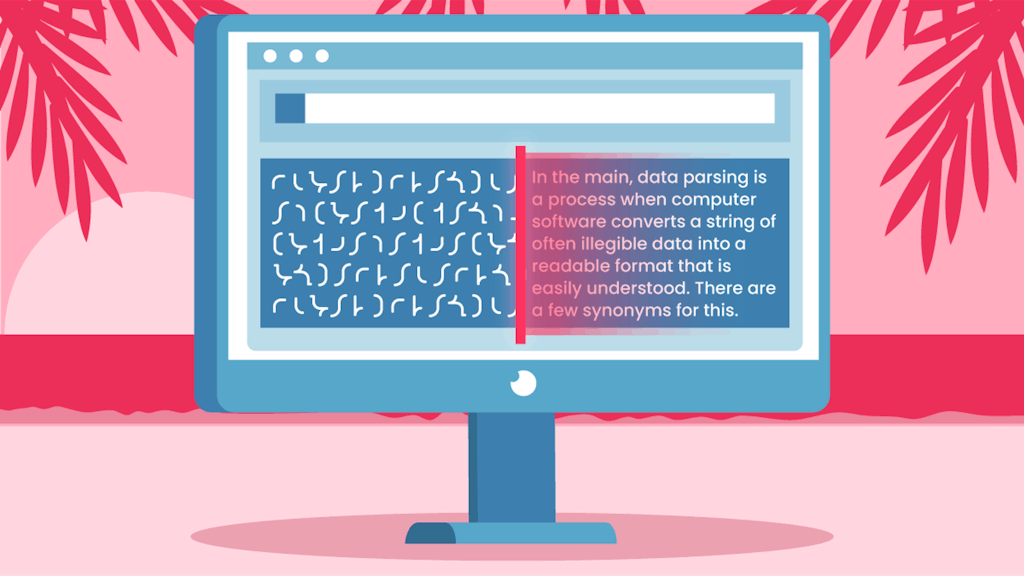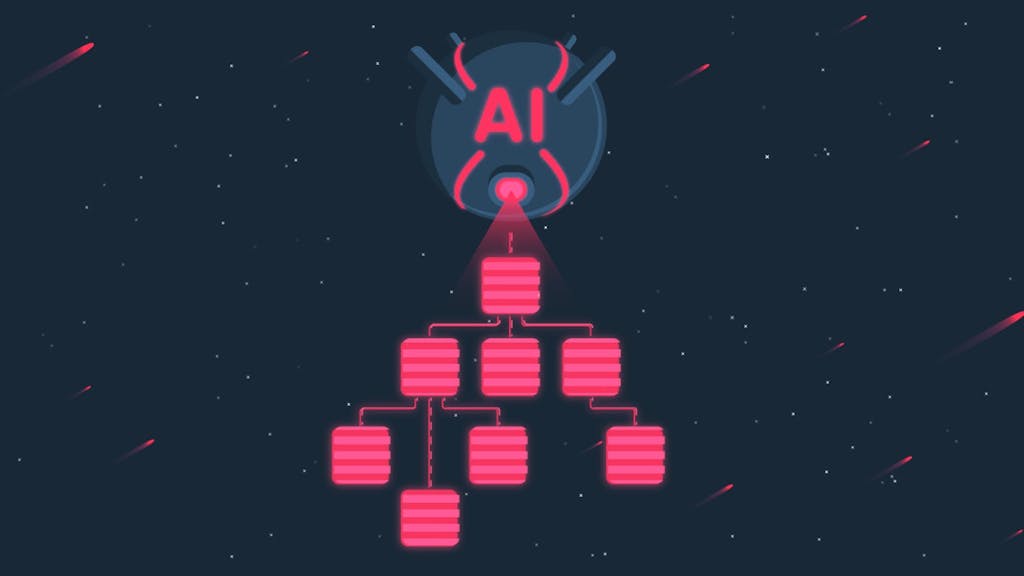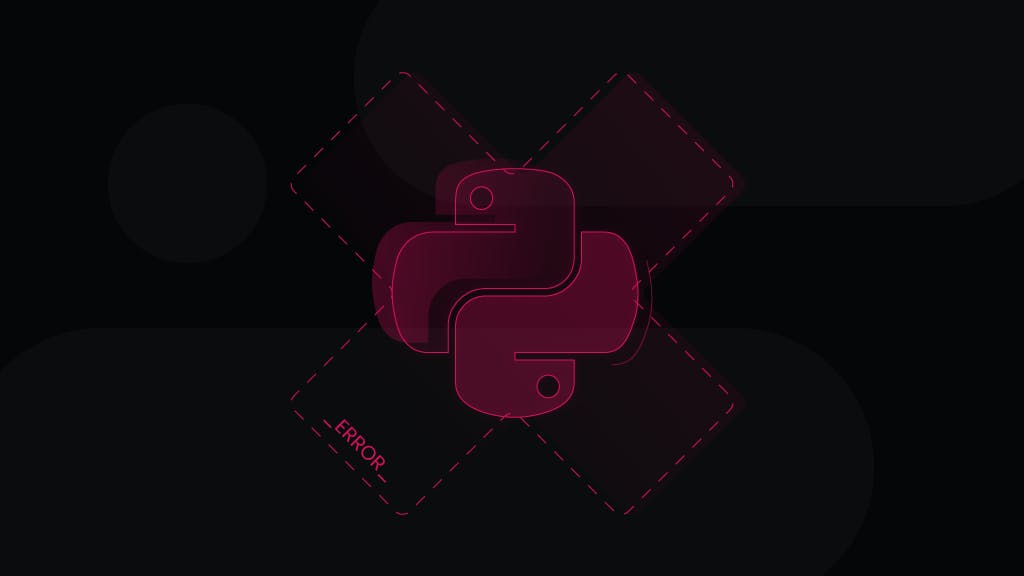Table of content
Digesting parsing: what is parsing? [VIDEO]
Just like we translate natural languages to have efficient international communication, we need to perform similar processes with programming languages to ensure success in computer sciences. That’s why parsing has emerged.
Data parsing is turning raw, unstructured data into well-structured and understandable information. So if you get data in raw HTML after scraping a page with proxies, you still must run that data through a parser. It will take the HTML and convert it into a readable format that you can easily understand.

- Smartproxy >
- Blog >
- Parsing >
Digesting parsing: what is parsing?
What is data parsing?
In the main, data parsing is a process when computer software converts a string of often illegible data into a readable format that is easily understood. There are a few synonyms for this process, including syntax analysis and syntactic analysis.
On a more technical level, a data parser is a software component that uses input data (e.g. HTML) to build a structural, readable representation of that input.
Parsers work with different formats of data. Everything depends on the code and the set of rules on which it’s built. For example, a parser can extract the needed information from an HTML string and convert it into JSON, CSV, a chart, or a table.

How does parsing work?
Parsing is not a straightforward process of analyzing strings of symbols in a computer language. It’s a two-step procedure where a parser is programmatically developed to know which data to read and how to analyze and transform it.
There are two components making up a data parser – lexical analysis and syntactic analysis. These are followed by semantic analysis, which doesn’t really fit under the umbrella of parsing but always goes after it. Below, we’re gonna digest all of them.

Lexical analysis
This is the first step of data parsing. It all starts when a string of raw, unstructured data enters the parser. Then, a lexer, also known as a scanner or tokenizer, transforms that stream of data into a sequence of tokens.
This step is lexical because the parser creates tokens by establishing meaningful lexical units, such as delimiters and keywords. At the same time, the parser discards lexically irrelevant information, such as parenthesis, comments, and white spaces.
Let’s say, the input character stream (2 + 8)^3 enters the parser. The lexer will split this stream into the following tokens: (, 2, +, 8,), ^, 3. Basically, lexical analysis is a process of token generation.
Syntactic analysis
The next stage is checking if the generated tokens make up an allowable, meaningful expression in accordance with pre-defined rules. Sounds super tricky? Keep on reading, we’ll try to make it clearer.
Here we need to introduce one more concept from computer sciences – context-free grammar. It’s a set of rules that specify the syntax of a language. Simply put, context-free grammar is about computer codes that define what is a valid sequence of tokens. It clearly defines what components can make up a valid expression in tokens and the order in which those components must go.
The result of syntactic analysis is a parse tree, consisting of branches with leaf nodes. Drawing a parse tree means drawing a hierarchical structure that shows which elements in the initial input are meaningful and what their role is.
In its simplest form, lexical analysis creates tokens, while syntactic analysis draws trees from those tokens.
Semantic analysis
The concept of parsing doesn’t include semantic analysis but this is something that always follows parsing. It’s performed by semantic analyzers, not parsers themselves.
Semantic analysis is a process of translating the initial source code (written in a high-level programming language) into object code (written in a low-level programming language). It’s a process that transforms source code into an executable program.
At this stage, semantic analyzers identify all the remaining errors from syntax analysis and generate an annotated parse tree, also known as an error-free parse tree. This stage is vital because parsing can’t detect all the errors in the source code.
If the initial string of symbols is free of errors, semantic analysis gives the green light for raw and unstructured data to become a clearly readable piece of information.
Types of parsers
The primary purpose of using parsers is to determine whether the input can be derived from the initial string of symbols, based on a pre-defined set of rules. There are two ways to do that: top-down and bottom-up.
.png?ixlib=gatsbyFP&auto=compress%2Cformat&fit=max&rect=2%2C0%2C1598%2C899&w=1024&h=576)
Parsing technologies
Data parsers go along with various technologies as they’re extremely flexible. Take a look at some examples of technologies that go hand in hand with parsing:
1. Markup languages.
HTML stands for Hypertext Markup Language. Developers use it to create websites and website apps that display data. XML is short for eXtensible Markup Language. It sets rules for encoding documents in a format that is human-and machine-readable.
2. Internet protocols.
Internet protocol languages such as Hypertext Transfer Protocol Secure (HTTPS) are at the heart of data communication for the internet. These protocols ensure secure communication over a computer network.
3. Database languages.
These languages help us read, update, and store information on databases. For example, SQL, or Structured Query Language, is one of the most popular programming languages that allows managing data in database systems.
4. Scripting languages.
These are programming languages that automate the execution of tasks without human interaction. Such languages define a series of commands that need no compiling. Web apps, multimedia, games, extensions, and plugins – all of them use script languages.
5. Modeling languages.
It’s an artificial graphical or textual language that expresses information in a specific structure defined by a set of certain rules. Developers, analysts, and investors use modeling languages to understand how the systems that they’re interested in work.
6. Interactive data languages.
IDL, i.e. interactive data language, is a programming language that proves extremely useful in data analysis and data visualization. Specialists from space sciences and solar physics use IDL on a daily basis.
7. General-purpose programming languages.
It’s quite likely that Java is the most popular programming language of this kind. It’s a class-based, object-oriented language that boasts its portability. Once you have written code for a Java program on a computer, it’s very easy to move that code to mobile.
How we do parsing at Smartproxy
Here at Smartproxy, we’re obsessed with data. That’s why we have a bunch of tools that can make your web scraping fast, smooth, and beneficial. First of all, if you’re using fully-developed products like Octoparse or Scrapy, don’t forget to employ residential proxies to boost parsing with those tools.
But the best thing is that we have our own solutions which can parse data. Our No-Code Scraper offers a selector that can identify and choose multiple fields of the same value with a single click. It’ll provide you with a table preview of collected data and the possibility to instantly export data in JSON or CSV formats.
In case your goal is to send millions of queries on Google, the simple proxy extension won’t work. For such tasks, you’ll need special tool, SERP Scraping API. It's easy to use. Just specify your query or URL, and Smartproxy will return well-formatted data in JSON.
Loading video...
Why parsing and artificial intelligence (AI) are inseparable friends?
So now we know that the data we get from web scraping is not well-structured and so lacks meaning if it’s not parsed correctly. We also established that parsing data is extremely complex. And it’s not only because parsing consists of two analyses, followed by semantic analysis.
The nature of the website structure is highly dynamic, too. Just imagine all those billions of websites around the world. All of them are different: their programming uses various codes, their formats keep changing all the time… That’s why parsers need maintenance and should adapt to different page formats.
If you had to keep up with the dynamics of web structures on your own, that’d take a lot of manual work, time, and resources. And still, you’d be extremely unlikely to fulfil all the tasks.
The solution here is to employ artificial intelligence (AI) along the way. AI will automate maintenance tasks and conduct your business operations at the speed of light. That’s why data parsing in the modern world is just impossible without the help of some “intelligence.”

What is Natural Language Processing (NLP)?
Natural language processing, or NLP for short, is a subfield of artificial intelligence that aims to define how to program computers to process, analyze, and represent large amounts of human language data. That said, we can’t imagine parsing without natural language processing.
Since natural language processing is all about how computers analyze and process extensive natural language data, parsing is not the only field where NLP plays a significant role. NLP is an essential part of the following area (just to mention a few):
- Machine translation
- Optical character recognition (OCR)
- Chatbots
- Voice enablement
- Statistics
So NLP is the technology that makes interactions between computers and human language possible. It empowers computers to comprehend natural language input and provide natural language output properly.
Parsing in soft sciences
When somebody hears “parsing,” they tend to associate it with computer science. And they are totally right! Computer geeks often talk about parsing in programming, Python, PHP, XML, JSON, HTML, Javascript, Java, or C++. Even this blog post so far has looked at parsing from a more technical point of view.
Yet, did you know that parsing also exists outside programming? Are you asking how this is possible? Below, you’ll discover how you can parse data in soft sciences.
Parsing in linguistics, or what is sentence parsing?
To parse in linguistics means to divide a sentence into its constituents to understand the meaning of the sentence. The most popular tool to do that is sentence diagrams. They visually represent the syntactic construction of a sentence.
A traditional method to perform sentence parsing is to distinguish the sentence elements and their parts of speech, e.g. nouns, verbs, adjectives, etc. The reader also takes notice of other elements such as the grammatical tense of the sentence, i.e. present, past, or future. Having done all that, the reader uses this analysis to understand and interpret the meaning of the sentence.
To make things clear, consider this sentence:
- Max needs some proxies.
To parse this sentence, we first need to identify the biggest components of the sentence, namely noun and verb phrases. In this case, Max is a noun phrase and needs some proxies is a verb phrase.
It’s also interesting to notice that this isn’t a simple verb phrase. It includes not only a verb (needs) but also a noun phrase (some proxies).
Then, we need to go deeper and establish the part of speech of each word. In our example, we can see a proper noun (Max), verb (needs), determiner (some), and noun (proxies). Finally, since the verb is needs, we can understand that the action hasn’t happened and the sentence is in the present tense.
This is a simple example. Yet, it shows how parsing can help understand the meaning of a text. Such visualizations are particularly useful when analyzing extremely long and complex sentences.
Parsing in psychology
When we’re talking about parsing in psychology, we’re basically thinking of parsing in cognitive psychology (or psycholinguistics). It’s a field of study that analyzes the relationship between languages and psychology.
Scientists in this field study and explain how the brain processes language to transform signs and symbols into meaningful statements. They seek to understand how different brain structures facilitate language acquisition and comprehension.
A very simple example of parsing in psycholinguistics is word associations. For example, when we hear the word “sneakers,” we might think of the following attributes associated with this word: sports, running, training, Nike, Adidas, rubber, etc.
Summing everything up
Parsing is a wide topic that found its way outside computer science and paved the way for further applications in soft sciences. We hope that we’ve managed to bring your understanding of data parsing up to snuff.
If you’re after ways to boost your business, register now to begin using our tools. And oh, if you have any questions about data parsing, chat with our customer support!

James Keenan
Senior content writer
The automation and anonymity evangelist at Smartproxy. He believes in data freedom and everyone’s right to become a self-starter. James is here to share knowledge and help you succeed with residential proxies.
Frequently asked questions
What are parsing synonyms?
Syntax analysis and syntactic analysis are synonyms for parsing.
Why do I need parsing software?
If you have proxies, you’re already scraping publicly available data with no limits. Yet, if you want to make data-driven business decisions that automate your tasks and optimize your workflow, you need to transform unstructured, raw data from scraping into clearly readable and understandable information. This is where parsing comes into the picture. For more information, there's a great blog post on parsing use cases.
What is resume parsing?
Resume parsing is the process of importing resumes into parsing software to extract information for further analysis. If you parse resumes, you can easily sort, store, and analyze data from them. Resume parsing is synonymous with CV parsing, resume extraction, or CV extraction.
What is email parsing?
Email parsing is the process of using parsing software to search for and extract specific data in an email. This can help you avoid manual data entry, saving you a lot of time, money, and resources.
What is the difference between crawling, scraping, and parsing?
Although these terms define different things, sometimes people use some of them interchangeably. Yet, there is a clear distinction between them:
- Crawling is a process of browsing the web automatically, i.e. navigating to pages, finding URLs in hyperlinks of those pages, copying them to a browser, and repeating the sequence again. This is usually accompanied by scraping tools that download the data from visited pages.
- Scraping is a process of gathering publicly accessible data for marketing and research purposes.
- Parsing is a process of transforming unstructured and hardly readable data into structured and understandable information.
By and large, crawling happens first, then follows scraping. Finally, the data gathered during scraping is further broken down into readable pieces during parsing.
What is indexing in search engines and how does it differ from parsing?
Indexing is a process of organizing information before a search to enable fast responses to queries. Indexing takes information from parsing, i.e. parsing breaks down raw data that indices can organize.
Related Articles

How to choose the best parser
Okay, let’s get it straight. Data is an awesome resource for analyzing and storing records, trends, and other information. But you can make rational decisions based on this information only if it’s shown clearly. That’s why we need parsing, a method to structure raw information. Parsing allows you to save time and increase productivity by converting massive amounts of data into neat and organized formats. Only then will we get the most important bits of that data. If you’ve found this blog post, chances are you probably have some idea of what data parsing is or at least have heard of it. So if you’re now looking for more information on what parsing can do and how to acquire parsing software, you’re in the right place.

James Keenan
Sep 02, 2021
6 min read

What to do when getting parsing errors in Python?
This one’s gonna be serious. But not scary. We know how frightening the word “programming” could be for a newbie or a person with a little technical background. But hey, don’t worry, we’ll make your trip in Python smooth and pleasant. Deal? Then, let’s go! Python is widely known for its simple syntax. On the other hand, when learning Python for the first time or coming to Python after having worked with other programming languages, you may face some difficulties. If you’ve ever got a syntax error when running your Python code, then you’re in the right place. In this guide, we’ll analyze common cases of parsing errors in Python. The cherry on the cake is that by the end of this article, you’ll have learnt how to resolve such issues.

James Keenan
May 24, 2023
12 min read